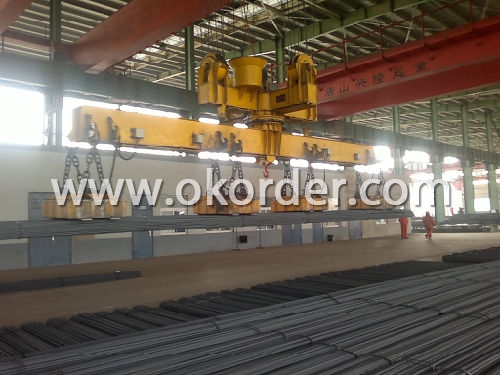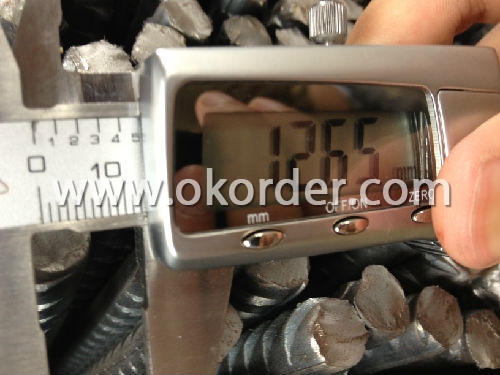HRB500 Deformed Steel Bar
- Loading Port:
- China Main Port
- Payment Terms:
- TT or LC
- Min Order Qty:
- 25MT m.t.
- Supply Capability:
- 800000/YEAR m.t./month
OKorder Service Pledge
OKorder Financial Service
You Might Also Like
Specifications of HRB500 Deformed Steel Bar:
Standard | GB | HRB500 |
Diameter | 6mm,8mm,10mm,12mm,14mm,16mm,18mm,20mm, 22mm,25mm,28mm,32mm,36mm,40mm,50mm | |
Length | 6M, 9M,12M or as required | |
Payment term | TT or L/C | |
Application | mainly used in construction industry to reinforce concrete structures and so on | |
Quality | First quality, the goods are from Chinese big manufacturers. | |
Type | Hot rolled deformed steel bar | |
Brand name | DRAGON | |
Chemical Composition: (Please kindly find our chemistry of our material based on HRB500 as below for your information)
Grade | Technical data of the original chemical composition (%) | ||||||
C | Mn | Si | S | P | V | ||
HRB500 | ≤0.25 | ≤1.60 | ≤0.80 | ≤0.045 | ≤0.045 | 0.08-0.12 | |
Physical capability | |||||||
Yield Strength (N/cm²) | Tensile Strength (N/cm²) | Elongation (%) | |||||
≥500 | ≥630 | ≥12 | |||||
Theoretical weight and section area of each diameter as below for your information:
Diameter(mm) | Section area (mm²) | Mass(kg/m) | Weight of 12m bar(kg) |
6 | 28.27 | 0.222 | 2.664 |
8 | 50.27 | 0.395 | 4.74 |
10 | 78.54 | 0.617 | 7.404 |
12 | 113.1 | 0.888 | 10.656 |
14 | 153.9 | 1.21 | 14.52 |
16 | 201.1 | 1.58 | 18.96 |
18 | 254.5 | 2.00 | 24 |
20 | 314.2 | 2.47 | 29.64 |
22 | 380.1 | 2.98 | 35.76 |
25 | 490.9 | 3.85 | 46.2 |
28 | 615.8 | 4.83 | 57.96 |
32 | 804.2 | 6.31 | 75.72 |
36 | 1018 | 7.99 | 98.88 |
40 | 1257 | 9.87 | 118.44 |
50 | 1964 | 15.42 | 185.04 |
Usage and Applications of HRB500 Deformed Steel Bar:
Deformed bar is widely used in buildings, bridges, roads and other engineering construction. Big to highways, railways, bridges, culverts, tunnels, public facilities such as flood control, dam, small to housing construction, beam, column, wall and the foundation of the plate, deformed bar is an integral structure material. With the development of world economy and the vigorous development of infrastructure construction, real estate, the demand for deformed bar will be larger and larger..
Packaging & Delivery of HRB500 Deformed Steel Bar:
Packaging Detail: products are packed in bundle and then shipped by container or bulk vessel, deformed bar is usually naked strapping delivery, when storing, please pay attention to moisture proof. The performance of rust will produce adverse effect.
Each bundle weight: 2-3MT, or as required
Delivery Detail: within 45 days after received advanced payment or LC.
Label: to be specified by customer, generally, each bundle has 1-2 labels
Trade terms: FOB, CFR, CIF
Deformed Steel Bar in stock

Deformed Steel Bar in testing

Note:
1. Our products are produced according to national standard (GB), if not, supply according to national standards (GB) or agreement as customer required.
2. Other Grade and Standard Deformed Steel Bar we can supply:
Grade: GR40/GR60, G460B/B500A/B500B/B500C,BST500S
Standard: ASTM, BS, DIN
The Minimum Order Quantity of these products is high, and need to be confirmed.
3. We can not only supply Deformed Steel Bar; if you need anything about building materials, please contact us for further information.
4. Please send us your detail specifications when inquire. We will reply to you as soon as possible. We sincerely hope we can establish a long stable business relationship.
- Q:What are the different types of steel rebars used in parking structures?
- The different types of steel rebars commonly used in parking structures include conventional carbon steel rebars, epoxy-coated rebars, stainless steel rebars, and galvanized rebars. These rebars are chosen based on their specific properties and resistance to corrosion, ensuring the structural integrity and longevity of the parking structure.
- Q:How do steel rebars perform in blast-resistant structures?
- Steel rebars perform well in blast-resistant structures due to their high tensile strength and ability to absorb and distribute the energy generated by a blast. The reinforcement provided by rebars helps to strengthen the concrete structure, minimizing the risk of collapse and enhancing the overall resilience of the building. Additionally, steel rebars can be designed and placed strategically to further enhance blast resistance, making them a crucial component in ensuring the safety and durability of such structures.
- Q:Are steel rebars suitable for use in sports stadium construction?
- Yes, steel rebars are suitable for use in sports stadium construction. Steel rebars provide excellent strength and durability, making them ideal for reinforcing concrete structures, such as stadiums, that need to withstand heavy loads and impacts. They enhance the structural integrity of the stadium, ensuring its safety and long-term stability. Additionally, steel rebars offer flexibility in design and can be customized to meet specific construction requirements, making them a preferred choice in sports stadium construction.
- Q:How do steel rebars prevent cracking in concrete structures?
- Steel rebars prevent cracking in concrete structures by providing reinforcement and strength. When concrete is poured, it is initially strong in compression but weak in tension. The rebars, made of high-strength steel, are embedded in the concrete to counteract this weakness. They absorb the tensile forces that occur due to bending or stretching of the concrete, preventing it from cracking. The rebars distribute the stress evenly throughout the structure, increasing its overall strength and durability. Additionally, rebars help to control the width and extent of any cracks that may occur, ensuring that the concrete structure remains stable and safe.
- Q:How do steel rebars prevent cracks in concrete?
- Steel rebars prevent cracks in concrete by providing reinforcement and increasing the tensile strength of the structure. As concrete is strong in compression but weak in tension, the rebars absorb and distribute the tensile forces throughout the concrete, preventing it from cracking under stress. The combination of steel rebars and concrete creates a composite material that can withstand bending, flexing, and other external loads, thus enhancing the overall durability and longevity of the structure.
- Q:How do steel rebars contribute to the sustainability of a building?
- Steel rebars contribute to the sustainability of a building in several ways. Firstly, the use of steel rebars in reinforced concrete structures enhances the overall strength and durability of the building, extending its lifespan. This reduces the need for frequent repairs or replacements, resulting in less material consumption and waste generation over time. Furthermore, steel rebars are made from recycled materials, with a significant portion being manufactured from scrap metal. This reduces the demand for virgin steel production, which is an energy-intensive process and contributes to carbon emissions. By utilizing recycled steel rebars, buildings can significantly reduce their carbon footprint and conserve natural resources. Additionally, steel rebars help in enhancing the structural integrity of the building, making it more resistant to various external forces such as earthquakes, hurricanes, and other natural disasters. This increased resilience reduces the potential for catastrophic damage and the subsequent need for major reconstruction or demolition, saving both resources and costs. Moreover, the use of steel rebars facilitates the construction of taller and more open spaces, allowing for efficient use of the building's footprint. This is particularly relevant in urban areas where land availability is limited. By enabling the construction of taller buildings, steel rebars contribute to urban densification, which helps in reducing urban sprawl and preserving natural habitats. Lastly, steel rebars are highly recyclable at the end of their service life. When a building is demolished, the steel rebars can be easily extracted and recycled, avoiding the accumulation of construction waste in landfills. Recycling steel rebars saves energy and reduces the need for extracting and processing virgin materials, further contributing to the sustainability of the construction industry. In conclusion, steel rebars play a crucial role in enhancing the sustainability of a building by increasing its durability, utilizing recycled materials, improving structural resilience, enabling efficient land use, and facilitating the recycling of materials at the end of a building's life cycle.
- Q:What is the process of reinforcing existing concrete structures with steel rebars?
- The process of reinforcing existing concrete structures with steel rebars involves several steps. First, a structural assessment is conducted to determine the areas that require reinforcement. Once identified, the concrete surface is prepared by cleaning and removing any loose or deteriorated material. Next, the rebars are positioned and secured to the existing concrete using epoxy adhesive or mechanical anchors. These rebars are strategically placed to distribute and support the additional load. Finally, the rebars are encased in a new layer of concrete called shotcrete or sprayed concrete, which acts as a protective and bonding layer. The result is a strengthened and more durable concrete structure capable of withstanding increased loads and extending its lifespan.
- Q:What is the maximum diameter of steel rebars available in the market?
- The maximum diameter of steel rebars available in the market can vary, but commonly ranges from 40mm to 50mm.
- Q:What is the role of steel rebars in preventing concrete spalling due to fire?
- Steel rebars play a crucial role in preventing concrete spalling due to fire by providing reinforcement and structural integrity to the concrete. When exposed to high temperatures during a fire, concrete can undergo thermal expansion, which can lead to cracking and spalling. However, the presence of steel rebars helps to restrain the expansion and prevent the concrete from breaking apart. The rebars act as a reinforcement, distributing the stresses caused by the heat and preventing the concrete from failing under the extreme conditions. Overall, steel rebars enhance the fire resistance of concrete structures and help maintain their structural integrity during a fire event.
- Q:How do steel rebars improve the strength of concrete?
- Steel rebars improve the strength of concrete by providing reinforcement and increasing its tensile strength. The rebars act as a framework within the concrete, helping to distribute the load and prevent cracks from forming. This reinforcement enhances the overall durability and structural integrity of the concrete, making it more resistant to bending, shearing, and other forces.
1. Manufacturer Overview |
|
|---|---|
| Location | Hebei, China |
| Year Established | 2002 |
| Annual Output Value | Above US$ 400 Million |
| Main Markets | South Asia; Middle East;Southeast Aisa |
| Company Certifications | |
2. Manufacturer Certificates |
|
|---|---|
| a) Certification Name | |
| Range | |
| Reference | |
| Validity Period | |
3. Manufacturer Capability |
|
|---|---|
| a)Trade Capacity | |
| Nearest Port | Tianjin |
| Export Percentage | 60%-80% |
| No.of Employees in Trade Department | 11-20 People |
| Language Spoken: | English; Chinese |
| b)Factory Information | |
| Factory Size: | Above 100,000 square meters |
| No. of Production Lines | 2 |
| Contract Manufacturing | OEM service offered |
| Product Price Range | average |
Send your message to us
HRB500 Deformed Steel Bar
- Loading Port:
- China Main Port
- Payment Terms:
- TT or LC
- Min Order Qty:
- 25MT m.t.
- Supply Capability:
- 800000/YEAR m.t./month
OKorder Service Pledge
OKorder Financial Service
Similar products
New products
Hot products
Related keywords





























